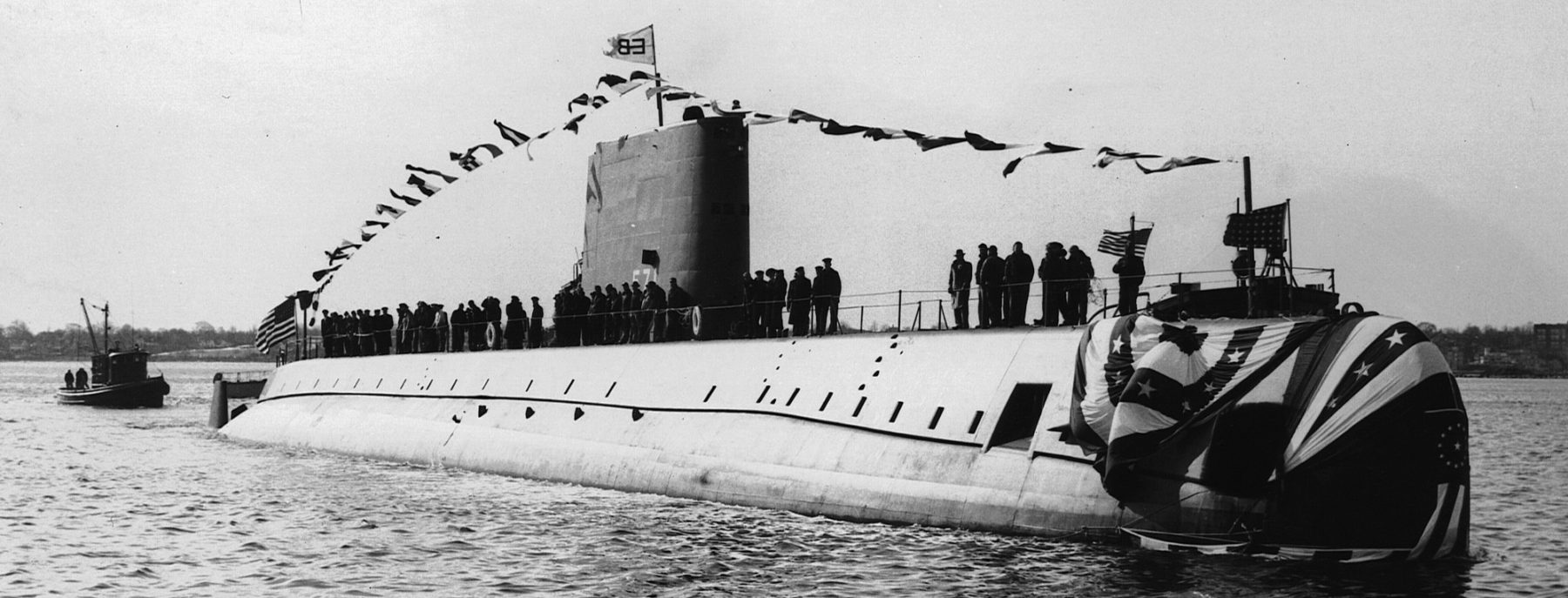
 Nuclear Attack Submarine 1952-1980, preserved.
Nuclear Attack Submarine 1952-1980, preserved.Cold War US Subs
GUPPY | Barracuda class | Tang class | USS Darter | T1 class | X1 class | USS Albacore | Barbel classUSS Nautilus | USS Seawolf | Migraine class | Sailfish class | Triton class | Skate class | USS Tullibee | Skipjack class | Permit class | Sturgeon class | Los Angeles class | Seawolf class | Virginia class
Fleet Snorkel SSGs | Grayback class | USS Halibut | Georges Washington class | Ethan Allen class | Lafayette class | James Madison class | Benjamin Franklin class | Ohio class | Colombia class
The world’s first nuclear submarine
The sub’s Propulsion Problem
In WW2 submarine propulsion remained what it was in WWI already, as developed in 1905-1910: Diesel-electric. Diesel engines were more compact, allowed more range for surface cruise, which was the “normal” state of any submarine -which needs to be called a “submersible” for this very reason- and emergency dives for attack or flee an attacker. Which were allowed by electric power, limited by the battery technology of the time. Construction methods limited depth as well. But underwater propulsion only allowed for short speeds (up to 9 knots and 14 with the late war Type XXI) in a short time. The favourite game of allied escorts was thus to “keep their head underwater” until they just gave up and surface to surrender, if not destroyed with gunfire. If something showed, is that Submarine could be very effective when deployed in packs, both in the Atlantic and Pacific.
The Type XXI did not have the time to be really operational in 1945, and was studied with great care by allied powers after the war. It showed the way forwards and indeed, all submarines retook the fundamental recipes of stremlining and greater electric power for better underwater speeds. As tested it could reach 17.2 knots (31.9 km/h; 19.8 mph) submerged and yet it was not enough to leave behind all allied escorts (destroyers were capable of 30+ knots) but at least left a better fighting chance to escape. Still, when performing high speed runs, batteries were rapidly depleted, and this could not be enough if the escorts were persistent, added to aviation which could spot these underwater if the conditions were right.
Thus on paper a new generation was needed. One that can make 25+ knots underwater for longer periods of time and not be handicapped by range. Given the technology of batteries in the 1950s this was simply not possible. No amount of batteries could be realistically fit into a submarine to achieve this without compromising all the rest. And batteries were still also unsafe at the time, between acids and fires. Steam power was tried a long ago and proved unsuitable. Navies were looking for a new AIP (Air Independent Propulsion), but apart hazardous chemical compounds like the Walter propulsion tested in WW2, nothing really worked. But there was a shortcut. The Manhattan project showed that uranium fission could be used in an explosive way, but some also argued that it could be tamed and controlled to produce heat, and thus indirectly, electricity. If nuclear power could be tested on land (it started in the US at Oak Ridge in 1946), one day it could be perhaps fit into a ship… or submarine. That was the opinion of Captain Rickover, a former submarine commander hismelf (S-9 and S-48 in 1929-1933), a central character in this story.
Eisenhower’s nuclear power dream
USS Nautilus is certainly a world’s history bending event. A landmark and a leap forward in submarine, but also ship technology regarding propulsion. In 1954, it enabled a new capability unheard of since the age of sail (already enabling unlimited range), coal (limited), and oil (less limited). If nuclear power did not catch up that well on surface ship (a few cruisers, aircraft carriers, almost all in the US) while being anecdotal for civilian use, it never really measured to Dwight D. Eisenhower’s dream of “atoms for peace” initiative, trying to turn over Oppenheimer (and other manhattan’s scientists) nightmare into a benefit for humanity. In the 1950s there was the fear of nuclear doomsday as well as a craze for “everything nuclear”. The army developed a range of tactical nukes, going as far as making nuclear shells fir its heavy artillery, or jeep-carried nuclear-tipped rockets, the first naval nuclear-tipped SAMs or SSMs missiles. As for propulsion, the Army studied its first tank, the Chrysler VT8. Ford even went further and even proposed a nuclear car, the “Ford Nucleon”, which never passed the mockup stage (fortunately
Eisenhower (“Ike”), former allied generalissimo in Europe, became president from 1953 to 1961, a crucial decade for the country, and he tried to turn the fear that inspired nuclear deterrence into a benefit to humanity, understanding that is the US would keep nuclear power in its military applications (and thus making the US the de facto “world’s gendarmes”), civilian applications would be accessible to the rest of the world. This also was accompanied by the Marshall plan and MDAP assistance to allies and would-be allies in the new chess game with USSR. Nuclear power as alternative to coal started to develop in the 1950s and stations “mushroomed” in the country.
As for the US Air Force, it didn’t wanted to be distanced, keeping the relevance of its recently forged MAD doctrine, based on nuclear bombers aloft at all times. They wanted to complete the loop with nuclear-powered bombers, which led to the creation of the Convair NB-36H. The Aircraft Nuclear Propulsion (ANP) program started as early as 1946, was crowned by a first flight in 1955, after USS Nautilus, and eventually closed in 1961, cancelled as impractical. It was killed because of unsufficient crew protection (lead shielding !), more than the irrelevance of bombers with the apparition of ballistic missiles, and the first SSBNs the same year. The nuclear tank was cancelled as well as any civilian projects for about the same reason: Nuclear radiation shielding. This war practical for building though, and nuclear plants mushroomed around the worlds, for the best -or worst after Chernobyl and Fukushima.
But where it failed in the air or the ground, it won underwater. Buoyancy allowed nuclear lead protection (or any other heavy material) to stop radiation. Between size constraints and displacement it was possible there. In this field, USS Nautilus was a prioneer. Nobody knew it was possible before some took the matter in their own hands. Admiral Rickover of course, but not only.
Development of Naval Nuclear Power in the US
The story already has been covered in part with USS Enterprise (which simply multiplied Nautilus’s reactors). Work on nuclear marine propulsion started in 1946-47 already. The first operational reactor was in 1953 and technology was setup from 1951 at Oak Ridge. These went into Nautilus reactors and, were stopped, then resumed by late 1954 for the large ship reactor project or LSRP, a kind of enw type of pressurized water type reactor with smaller core, tighter space, highly enriched fuel and less extensive shielding. This Mark 1 reactor delivered 60 MW in 1957, compared to 200MW in land installation which did not had all these constraints. This one went later to USS Long Beach and Enterprise.
Rickover’s drive towards the first SSN
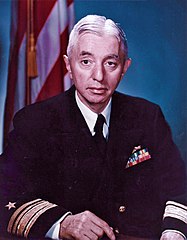 It is hard to underestimate the performance of Hyman G. Rickover. Albeit a somewhat abrasive peronality, the man was instrumental in this development. Now dubbed the “father or US Nuclear Submarines” he was by December 1945 Inspector General of the 19th Fleet (west coast), and working with General Electric, Schenectady, New York on a very early project of nuclear propulsion plant. Her intended them for destroyers, as one of the major critic of the type since decades in all navies but especially the USN in the pacific was to “give them legs”. In 1946, a teamed up with Manhattan Project’s Clinton Laboratory, now Oak Ridge center. The goal was to create even a primitive nuclear electric generating plant. The intermediate, as general groves was for Manhattan, with the Pentagon and the Navy, was Rear Admiral Earle Mills, later crucially posted at Bureau of Ships.
It is hard to underestimate the performance of Hyman G. Rickover. Albeit a somewhat abrasive peronality, the man was instrumental in this development. Now dubbed the “father or US Nuclear Submarines” he was by December 1945 Inspector General of the 19th Fleet (west coast), and working with General Electric, Schenectady, New York on a very early project of nuclear propulsion plant. Her intended them for destroyers, as one of the major critic of the type since decades in all navies but especially the USN in the pacific was to “give them legs”. In 1946, a teamed up with Manhattan Project’s Clinton Laboratory, now Oak Ridge center. The goal was to create even a primitive nuclear electric generating plant. The intermediate, as general groves was for Manhattan, with the Pentagon and the Navy, was Rear Admiral Earle Mills, later crucially posted at Bureau of Ships.
But Rickover’s difficult relations with hierarchy saw him soon sidelined in an “outcast” bureau and frequently marred in his attempts to shake up the Navy top brass about his projects. In the en he resolved to directly went over their heads to legendary CNO Fleet Admiral Chester Nimitz, a former submariner himself, which he personally knew, and who he believed to quickly grasp use of the concept. Nimitz in turn soon had the current Secretary of the Navy, John L. Sullivan, in the loop, and this enabled an order for USS Nautilus in 1951. Construction took another year for setup and went on ffrom built to 1952 1954, a remarkably short time due in large part to Rickover’s constant ” breathing down the neck” attitude with the construction team, whic hwas of course General Dynamics, Groton.
The STR nuclear reactor (later S2W) soon reliable enough to become USS Nautilus’ main reactor. Still under Rickover’s the drive for an improved model led to the A2W, for a first aircraft carrier. The Nautilus success made Rickover Director of the Naval Reactors Branch in the Bureau of Ships until 1982. He would also supervise the next generation of nuclear submarines, and its first class, the Skipjacks.
The boat: USS Nautilus Technical challenges
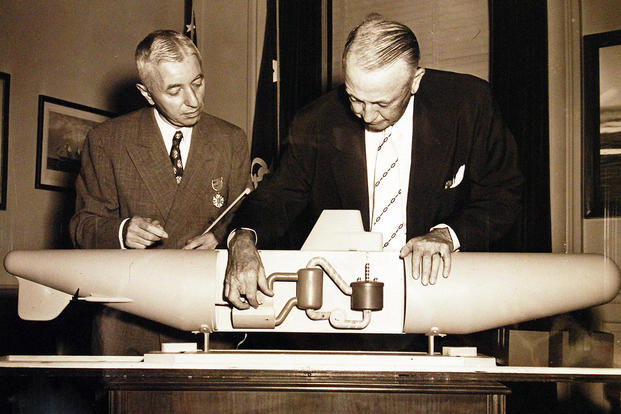
Hyman Rickover and Dan Kimball. The path was hard to success as Rickover was recalled by top brass from Oak Ridge to Washington as “advisors” with his team in 1947 as his did not followed orders to focus on nuclear plant for destroyers, but instead focused on submarines. He worked after hourse without authorization, got caught, and was forcibly relocated to an abandoned ladies bathroom and practically muted until he found his former CO in 1930, Chester Nimitz…
Building the first nuclear submarine for the navy did not have to start from a blank page. Apart the reactor section and it’s command post, which defined the central section of the new sub, the rest was more “navy grade” and needed to answer to the classic roles of a USN attack submarine, by the way the only known type before the advent of SSBNs. And what was between the WW2 mass-built GATO/Balao/Tench classes and Nautilus ? After obtaining two of the German Type XXI, including one captured and in perfect working order, it was clear that the technology shown dictated changes in ways submarines were built.
So on one hand, the USN started an ambitious conversion program of its WW2 fleet, named the “Greater Underwater Propulsion Program”. On the other hand, budgets were obtained to built prototypes of a modern, tailored attack submarine. These were the first three small USS Barracuda class launched in 1951 and more importantly the much larger Tang class also launched in 1951 and much closer to an ideal “USN Type XXI”. When worked started on USS Nautilus, there was an even more evolved version called USS Darter (SS-576), and experimental model based on the Tang class but incorporating many improvements and built by the Electric Boat Division of General Dynamics (Groton, Connecticut) just after USS Nautilus: She was ordered on 30 June 1954, laid down on 10 November 1954.
Specifics of the SCB 64 program
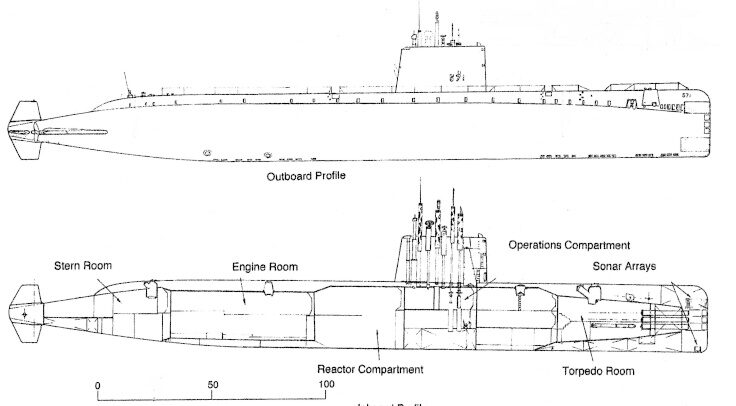
The hull and most systems of USS Nautilus, were thus borrowed from the Tang class. The latter were being launched already when the Congress authorization of July 1951 related to the SCB 64 program came. Plans of the Nautilus could both benefit from the design of this class in large part, as well as the improvements planned for USS Darter. Conceptual design began in March 1950 under this project SCB 64 name. It was planned and personally supervised by Captain Hyman G. Rickover at the time. Assigned to the Bureau of Ships in September 1947 and trained in nuclear power at Oak Ridge (Tennessee) her wrote reports about possibilities of nuclear ship propulsion until February 1949 when he received assignment to the Division of Reactor Development and U.S. Atomic Energy Commission, and then after shortcircuiting the hierarchy, became director of the Naval Reactors Branch at the Bureau of Ships, and from there spent all time on SSN-571 from 1950 to the latter joining the fleet in January 1955. However the path was tortuous as he was initially assigned in 1946 the task of fitting a reactor on a destroyer and clearly disobeyed.
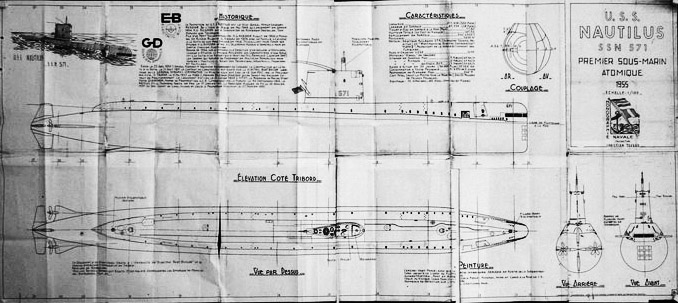
After he went directly to Nimitz to get his project approved, he found the only yard that accepted to work on it (a civilian contractor) the historical pioneer (of J. Holland fame), Electric Boat of Groton in Connecticut. Indeed naval yards at the time were understaff, underfunded and often behind schedule, and waiting not only for top brass but also congress approval. However Rickover was getting any of this, knowing the technology was there. Then after refining the project, he went to setup a construction time table obtained costs estimation, returned to the Navy office, but top brass refused to fund the project, obstructing him again. So captain Rickover went to Washington DC where he met congressmen and senators he already befriend with during his previous assignation back in the days, and soon obtained a congressional hearing to get the funds. One key advantage in this was the signed approval of CNO Chester Nimitz and he played all the cards he had.
The Congress eventually approved the project in July 1951, so that the design could be at least refined back at Groton.
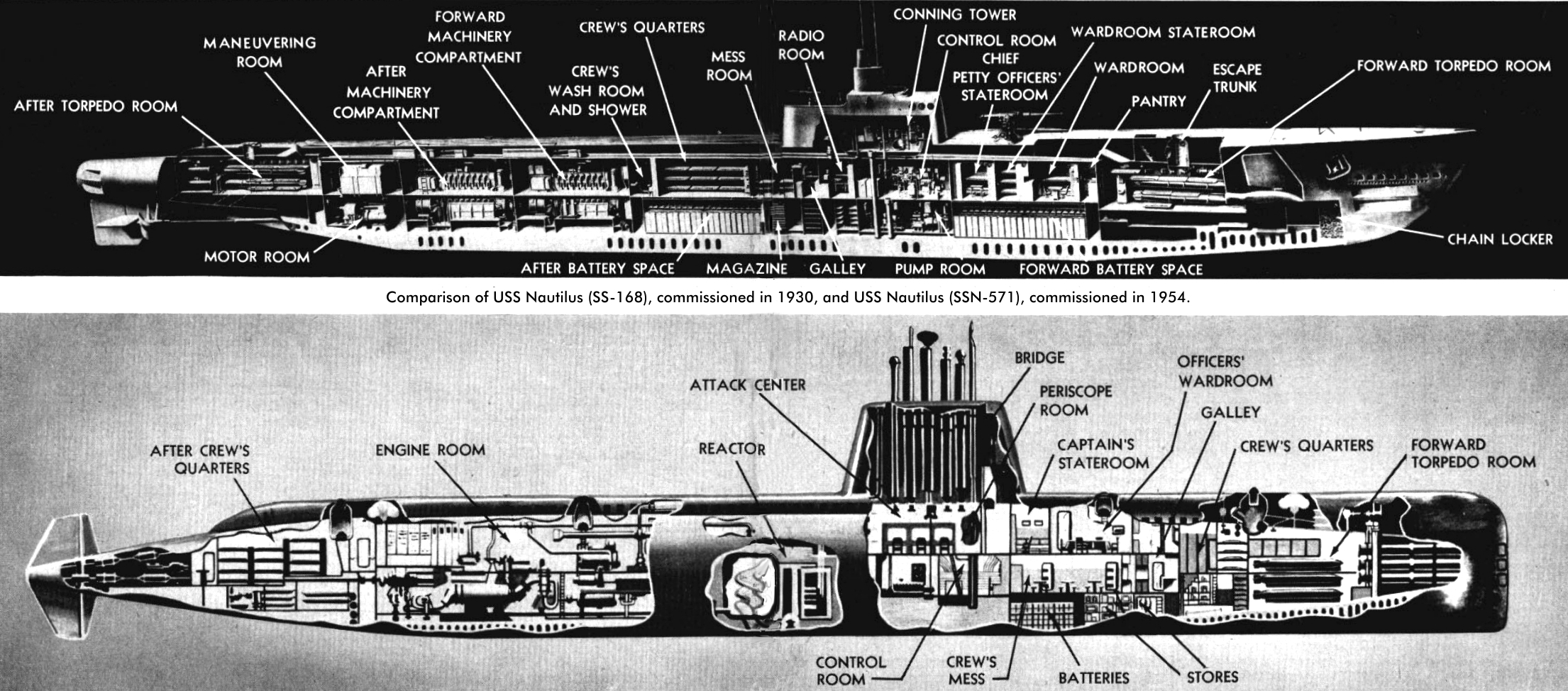
Tech drawing, comparative of SSN 571 and 168, the two Nautilus of the USN – Popular science
Proper blueprints were established, but this was a complicated process, even though the plans of both the Tang class and USS Darter could be worked out. The final product was way larger and more complex, and it was just a mere “jumboisation” of those to fit in a new section containing the pressurized reactor (PWR). So that only by June 1952, almost a year after, that SS-574 keel is laid down at Electric Boat shipyard. All this time, Rickover was not present, forced to work on petty assignations back in Washington DC, instead he sent frequent letters and one of his colleagues to Groton to report on the progress and help polishing even minor details.
Construction
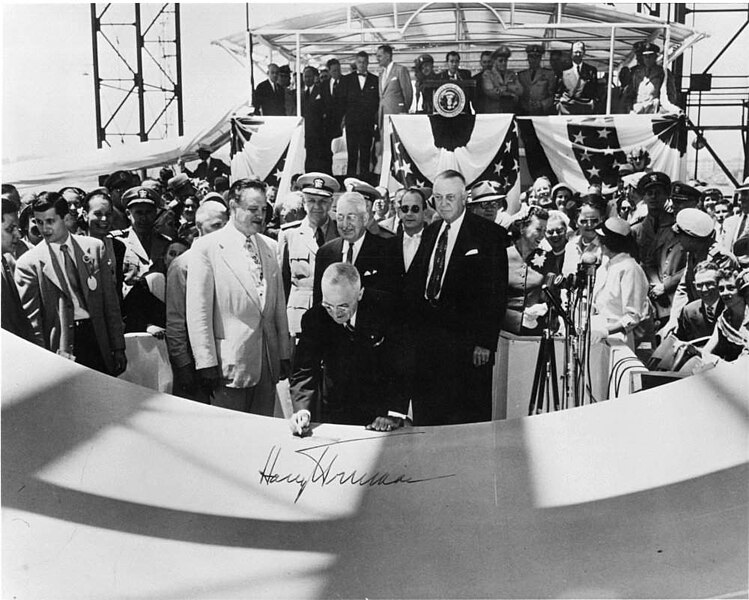
Nautilus’s keel was laid at General Dynamics’ Electric Boat Division in Groton, Connecticut, by Harry S. Truman on 14 June 1952, with fanfares, flags and Congressmen there. However since the Navy was responsible for it, Rickover was not invited, kept in his Washington makeshift office. Thge press and congress noted his absence as well, which led to some rumble towards the navy in 1953.
Navy anger towards him costed three times a promotion: He was passed over until not elegible anymore for promotion, meaning no longer desirable in the Navy, thus forced to retire from the project due to seniority issues. However in 1953 his Congress friends talked to Navy secretary to get him a rare “special election board” promoting him to rear admiral so the “father of nuclear subs” could stay at his post, still against the Navy which did not lacked epithets and birds names for the man.
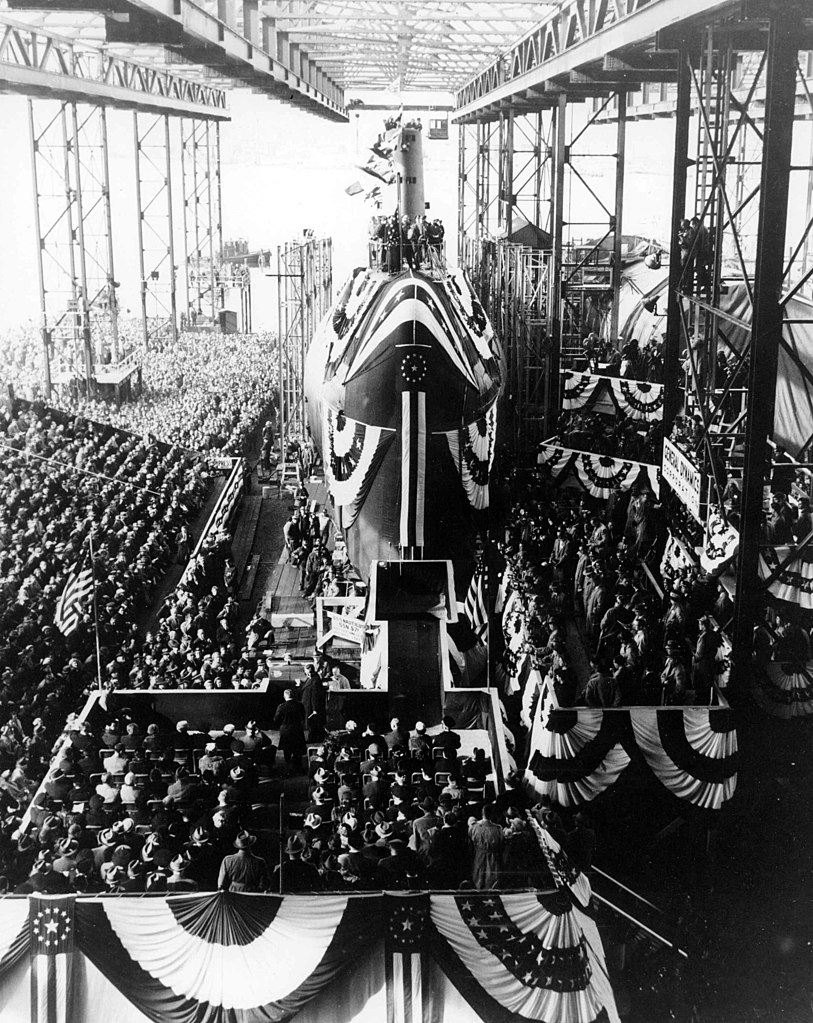
120120-N-ZZ999-003.WASHINGTON (Jan. 20, 2012) In this file photo taken Jan. 21, 1954, spectators gather around the nuclear-powered submarine USS Nautilus (SSN 571) during a christening ceremony. (U.S. Navy photo/Released)

The christening launch by Mamie Eisenhowever, also in presence of Chester Nimitz (no longer CNO) and the same congressmen and RADM Rickover this time, on 21 January 1954. She slipped into the Thames River.
However this was certainly not done yet, a lot of extra work was necessary until she was commissioned on 30 September 1954 (again in presence of Rickover), so almost two years after launch. It happened under command of Commander Eugene P. Wilkinson, first captain.
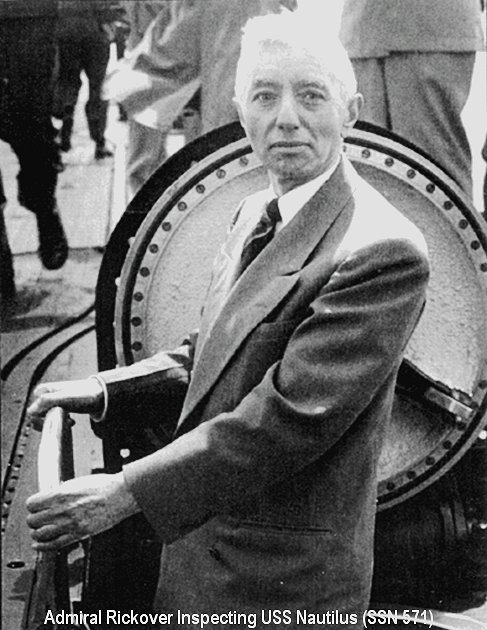
RADM Rickover inspecting his boat after completion. The inflexible “KOG” (Kind Old Gentleman) eventually had its way and became another American hero in the eyes of the general public. The photo is very reminiscent of John Holland and his bowler hat emerging from the hatch of his creation, USS Holland (SS1).
Naming
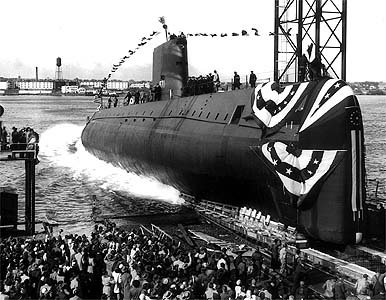 By 12 December 1951, the US Department of the Navy announced the name was chosen, “Nautilus”. It was the fourth USN vessel named that way assorted by the hull number SSN-571. The name “nautilus” was the scientific one for a pelagic marine mollusc of the cephalopod family Nautilidae, but it was also famously one of a revolutionary submarine at the time the concept was in its early infancy. When “Twenty Thousand Leagues Under the Seas” was published in 1871 by French author Jules Verne from 1969 (1873 in the US) it had a worldwide impact in its depiction of future underwater exploration. After its enigmatic captain “Nautilus” was the other main protagonist, a submarine powered by a “new formidable energy source” (not steam). Parallels seems obvious. It seems planned, as Walt Disney’s “20,000 Leagues Under the Sea” Ft. James Mason and Kirk Douglas aired on 1954 and the combination of both had quite an impact on the US public at the time.
By 12 December 1951, the US Department of the Navy announced the name was chosen, “Nautilus”. It was the fourth USN vessel named that way assorted by the hull number SSN-571. The name “nautilus” was the scientific one for a pelagic marine mollusc of the cephalopod family Nautilidae, but it was also famously one of a revolutionary submarine at the time the concept was in its early infancy. When “Twenty Thousand Leagues Under the Seas” was published in 1871 by French author Jules Verne from 1969 (1873 in the US) it had a worldwide impact in its depiction of future underwater exploration. After its enigmatic captain “Nautilus” was the other main protagonist, a submarine powered by a “new formidable energy source” (not steam). Parallels seems obvious. It seems planned, as Walt Disney’s “20,000 Leagues Under the Sea” Ft. James Mason and Kirk Douglas aired on 1954 and the combination of both had quite an impact on the US public at the time.
Disney collaborated with the Navy for the interior decoration as well, with the wardroom displaying a set of tableware made of zirconium (like the nuclear fuel cladding) and designed the ship’s patch, probably as a return gesture for the name choice. It is often forgotten by Walt was also a visionary and futurist perfectly in line with the naive enthusiasm for the nuclear technology of its time. “USS Nautilus” has been previously attributed to SS-168, a Narwhal-class submarine (1930–1945), USS H-2 (SS-29) during construction (later changed to a simple number) and USS O-12 (SS-73) carrying symbolically this name during a civilian arctic expedition in 1931.
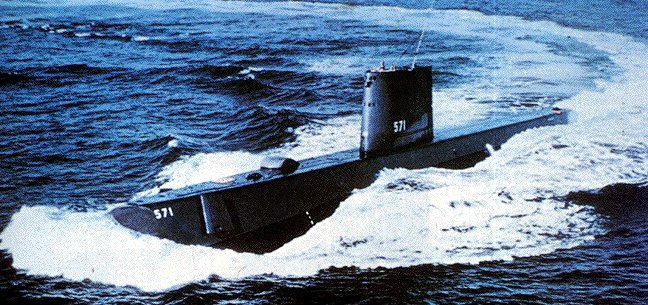
USS Nautilus Underway
Main Hull and Specifics
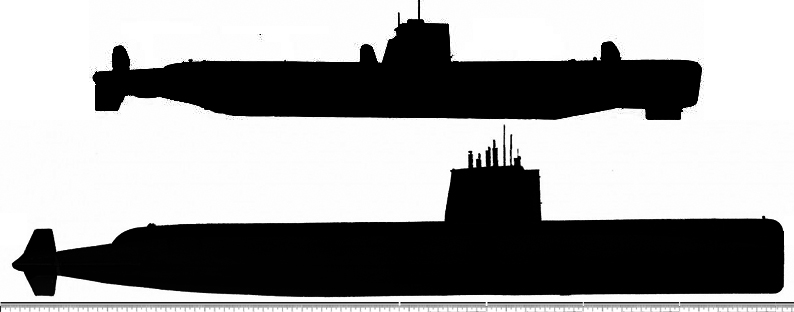
Comparison between USS Tang and Nautilus
USS Nautilus was essentially a “scaled-up” and well modified Tang class. She was displacing 3,533 long tons (3,590 t) surfaced and 4,092 long tons (4,158 t) submerged versus 1,560–2,050 surf./2,260–2,700 long tons submerged and far larger, nearly reached 100 meters 320 ft (97.5 m) by 28 ft (8.5 m) in beam and 26 ft (7.9 m) in draft versus 277 ft by 27 ft by 17 ft. They did not playes in the same category. The very early design when first presented with Dan Kimball almost looked like a GUPPY type with a large powerplant taking most of the internal space. The final boat was massive, in fact she was the largest US submarine ever built, larger than 1927 USS Argonaut. The Japanese I-400 still had the record at the time. With her beam to lenght ratio she still could take advantage of her raw power, while her beam to height ratio ensured good agility, at least all things measured for such large submarine.
The prow shape was before the age of “teardrop” and thus still inspired by the Type XXI design, narrow forward but rounded, with a straight section, and then rounded again downards with increased width down to the belly. The latter was straight to about 3/4 of the end, then ending with the Tang class in straight line up to the location of the cross-style tail. The streamlining was important, and this part was well rounded, apart the upper end of the “deck”. Two shafts protruded fro mthis section, ended short of the horizontal tail.
The deck had a flat section going up to the raised end above the tail. Just underneath were located the crews quarters.
The USS Nautilus was also the first submarine in US history to have three full decks in the pressure hull. The conning tower was inspired by the ones fitted on later variants of the GUPPY converted subs. It consisted in a large water-filled aft part comprising all the various masts (in order main persicope, two radar and two antennae masts, intake snorkel mast and snorkel exhaust). The forward part where the ladder well accessed, comprised three levels, the navigating room, the surface bridge (with portholes) and above, the access room to the open bridge.
The attack center with all consoles and boatswain position, were located behind the CT as customary. Below the CC were located the radar machinery, mess and fresh water tanks.
The forward section comprised three levels, with the Captain’s statesroom, officer’s wardroom, below the crew’s mess and galley, a small nuclear lab, and below, batteries and food stores. After the forward crew’s quarters were located the armament’s room, with the spare torpedoes, controls, loading and maintenance equipments, then the six torpedo tubes. Above it was located the forward escape hatch and signals ejector.
Access to the rear was through a cramped passage above the recator section to the upper machinery space level. An engine room hatch was located above, through the upper section of the outer hull; The main machinery control room was located aft of it. Then came the aft escape hatch, and aft crew’s quarters. They still have to access the forward section’s mess to eat, so often meals were carried at some hours to their section. The galley was to feed thrice a day a crew of 13 officers, 92 enlisted, plus on-demand snacks and meals for the Captain and officers. Since range was on paper unlimited, and the food stores were not much larger than on previous generation SSKs, it was the achilles heal of the sub and resplenishments at sea had to be planned (or half-supplies via helicopter’s packages). The latter solution also used to transfer personal, allowed the sub to remain surfaced for a much shorter time. The crew had at least two professional divers that can retreive any heliborne packages or personal.
Later SSNs and SSBNs had far larger food stores as well as new types of dehydrated food rations which took far less internal bulk.
On that topic, about one third of the lenght was reserved to the nuclear reactor module and the engine room behind. For simplification, only forward Torpedo tubes were fitted.
For her paint scheme, she had a medium gray supestructure (above water part), as the conning tower, with darker reddish decks, small id number on the CT, and black underwater hull, not red. The red paint primer used as anti-fooling material was still there, but an anechoic black paste was painted over it, one early way to deal with noise reduction.
Powerplant & Performances
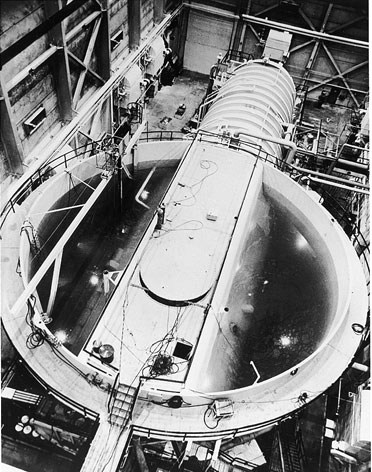 Left: Nautilus’s reactor core prototype at the S1W facility in Idaho. The beating hart of the vessel was its S2W reactor, S for “sub”, 2 as it was the core generation, and W for Westinghouse. This reactor was the shipborne equivalent of the prototype S1W with minor design changes, generating 13,400 horsepower (10.0 MW) and originally called STR.
Left: Nautilus’s reactor core prototype at the S1W facility in Idaho. The beating hart of the vessel was its S2W reactor, S for “sub”, 2 as it was the core generation, and W for Westinghouse. This reactor was the shipborne equivalent of the prototype S1W with minor design changes, generating 13,400 horsepower (10.0 MW) and originally called STR.
Located close aft to the conning tower, it was composed of an outer and innder shield for better protection, in which was located the core itself and its rods and their drive motor, the enclosure being cooled by water through a loop. There was no Water entries into the core which just boiled water and produced heat by indirect proximity.
This was turned into steam feeding two classic (also Westinghouse) geared steam turbines via a main upper steam line, driving two shafts. The indirect loop system was there to avoid any contamination, superheating steam being pushed to the turbines behind. Thus was the return of steam power into a submarine as there has been no way to obtain this steam with and air-independent system so far.
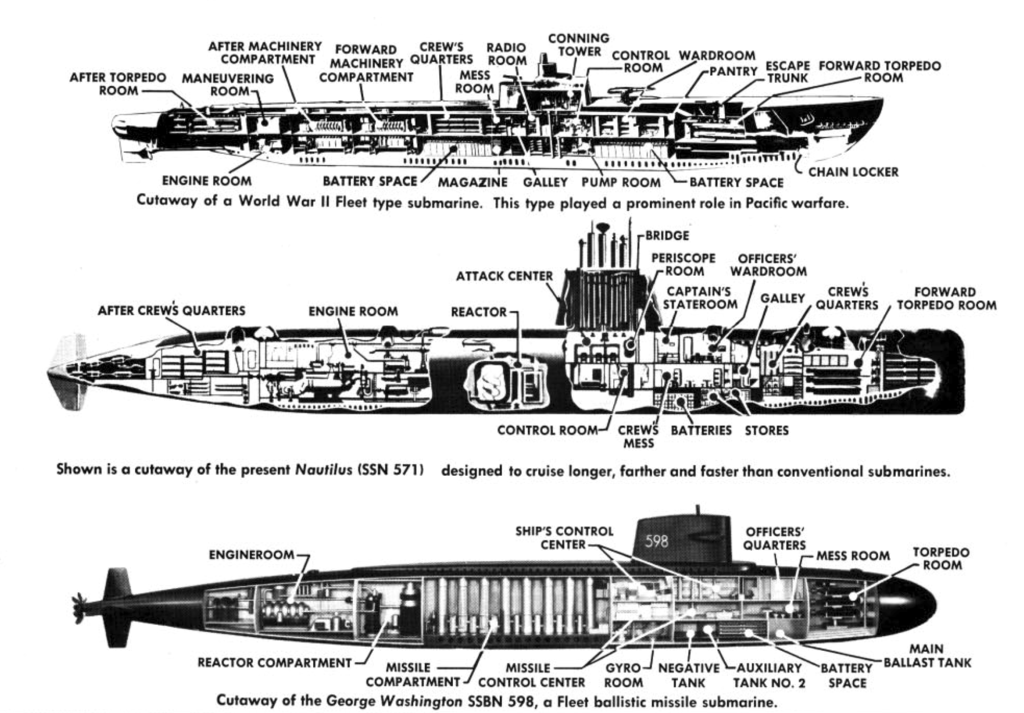
Differences between all three submarines types from the 1940s GATO class to the 1967 Los Angeles class
This power was passed onto two 5-bladed propellers, of a new design. They were changed after a refit to 7-bladed screws. This enabled a 22 knots surface speed, excellent at the time (15.5 kts for Tang and Darter), and 25 knots underwater (versus 16 kts) so it also blew away every and any design so far. However later on trials she experienced issues preventing her to reach this speed, not related to power but essentially vibrations, and so noise. In practice it was reduced to 23 knots at best (43 km/h; 26 mph).
She could dive up to 700 feet, which also was about the same as USS Darter (Test depth 210 m). Submerging time was greater than the previous attack subs however due to her larger size.
USS Nautilis had other sources of power. There were two electric generators which can be fed by two small diesels as backup, and batteries, located in the third deck.
Armament
She had six Mark 50 torpedo tubes of standard type (21-in or 533 mm) all in the bow close together on the straight section, behind three series of openings on either side. At this time, these were still of the trusted 21″ (53.3 cm) Mark 35 type (design 1946, service 1949) weighting 1,770 lbs. (803 kg) for 13 ft 5 in (4.089 m) in lenght, carrying a 270 lbs. (122.5 kg) HBX warhead to 15,000 yards (13,710 m) at 27 knots and powered by an Electric-Battery coolded by seawater and guided by active and passive acoustic system, with spiral search. This model stayed in service until 1960.
So it got rid of the aft tubes of the uss Darter, way smaller. This was criticized by the Navy, but technically there were few ways to have these installed.
These tubes had two reloads each and more, so 22 in all. Again compared to the size of the new sub, this also was criticized. She was fit for great patrols but lacked the torpedo supply to really take advantage of this.
During her major refit of the 1960 she mostly received a new ECM suite WLR-1 to replaced her original BLR-1 system, but perhaps also obtained new torpedoes of the 21″ (53.3 cm) Mark 39.
These entered service in 1956, weighting 1,275 lbs. (578 kg) for 11 ft 1 in (3.378 m) in lenght, so being actually shorter, carrying also a smaller 130 lbs. (59 kg) HBX warhead, and at shorter range of 13,000 yards (11,890 m) at 15.5 knots (Electric Battery) but what was new was her guiding system, using Wire and passive acoustic sonar. It was far more accurate. It’s also possible USS Nautilus kept both types until the end of her service.
Sensors

Fleet Admiral CW Nimitz and officers are presented USS nautilis by Capt. Anderson after his exploit.
USS Nautilus was equipped with a set of radars for surface scanning and sonars.
BPS-12 radar: Medium-range surface search and navigation radar, modified BPS-5, similar to BPS-14.
BQS-4 Sonar(as completed):. Active/passive detection with AN/BQR-2 passive detection and active detection system with vertically stacked cylindrical transducers located inside the BQR-2 chin bow dome, from which it transmits its active “pings”. In addition to passive listening, the sonar can operate in either automatic echo-ranging or “single-ping” modes. Later updated to the BQR-4A.
BLR-1 EW suite: Radar warning receiver (RWR).
Replaced in 1962 by WLR-1 system, shipborne radar warning receiver for real-time intercept, direction-finding, processing and evaluation of radio-frequency signal emitters in the 0.5-18 GHz (C to J) bands.
The Nautilus had also two sets of long range communications antennae, receiver and transmitter.
Career of USS Nautilus
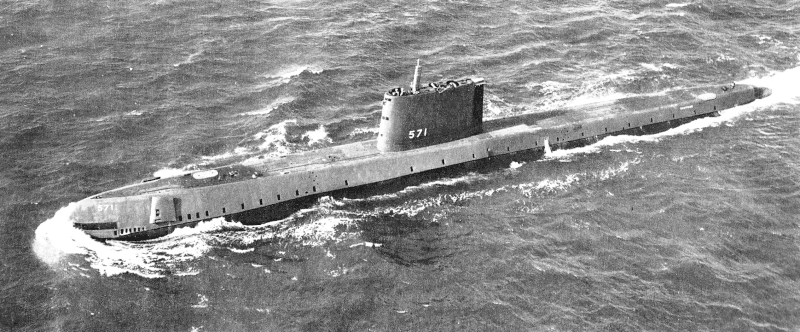
USS Nautilus during its initial sea trials, 20 January 1955
Following her commission on 30 September 1954, under command of Commander Eugene P. Wilkinson, she remained dockside for further testing and fixes. On by 17 January 1955, 11 am Wilkinson, ordered all lines cast off, signalling “Underway on nuclear power” for a first round of sea trials. On 10 May she travelled submerged to Cuban waters for her shakedown over 1,100 nmi (2,000 km; 1,300 mi) from New London to San Juan in Puerto Rico, and in less than 90 hours, part of it was done at max speed more than two hours, setting a world record.
1955-1957 saw her testing her new plant in a wide range of runs, increasing submerged speeds and multiplying endurance tests. On 4 February 1957, she registered her 60,000th nautical mile (110,000 km or 69,000 miles), a wink to her fictional contermart in Jules Verne’s “Twenty Thousand Leagues Under The Sea”. In May 1957 she transited the Panama Canal to the Pacific Coast for exercises with the fleet and take part in Operation Home Run starting to train ASW groups to the presence of a nuclear submarine.
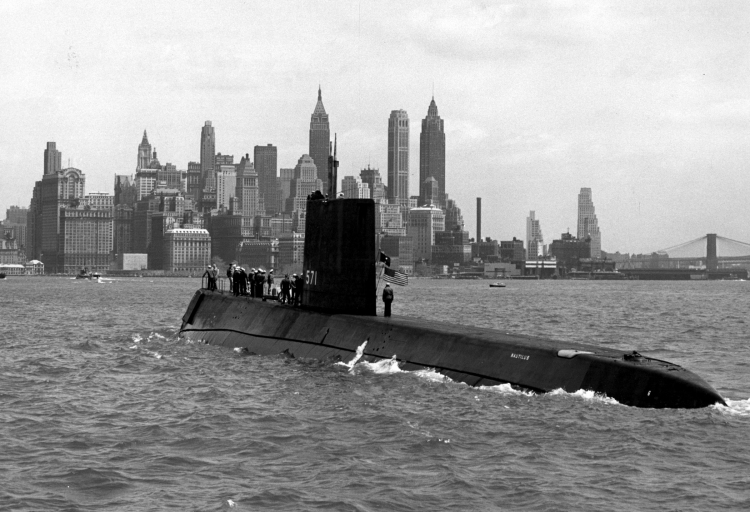
Nautilus after passing under the George Washington Bridge, visits New York Harbor in 1956
USS Nautilus was back to New London (Connecticut) on 21 July for a short resupply and crew’s leave, but departed on 19 August for her first voyage 1,200 nmi (2,200 km; 1,400 mi) underwater test trip under the polar pack ice. Next she sailed to the Eastern Atlantic for various NATO exercises, making numerous port calls in Europe, notably British and French ports where, where she was inspected by defense personnel there. Back at HP New London (28 October) she stayed for upkeep. The next spring she made post-overhaul trials and coastal operations.
Operation Sunshine:
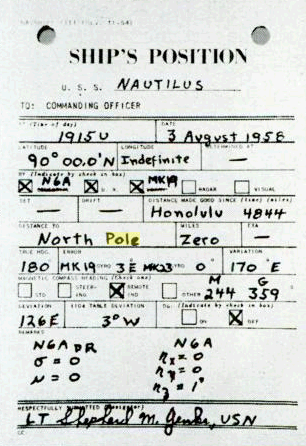 < Navigator's report: Nautilus, 90°N, 19:15U, 3 August 1958, zero to North Pole. Her shining moment arrived when President Eisenhower wanted to answer Soviet achivement with Sputnik, which also went with the new Soviet ICBM threat. Her asked the submarine a transit of the North Pole, which would be at the same time a prestige feat, record setter, scientific endeavour and on the other hand, reinforce SLBM trials. It prepared the venue for better SSBNs in the USN. On 25 April 1958, USS Nautilus went for the West Coast under command of William R. Anderson, stopped at San Diego, San Francisco, Seattle on her way north, and departed along the coast for her polar transit from 9 June. On the 19th she was in Chukchi Sea, but deeper than expected drift ice in those shallow waters rebuffed her to another path. On the 28th she was back at Pearl Harbor to await better ice conditions, which was still not well understood, albeit seasonal.
< Navigator's report: Nautilus, 90°N, 19:15U, 3 August 1958, zero to North Pole. Her shining moment arrived when President Eisenhower wanted to answer Soviet achivement with Sputnik, which also went with the new Soviet ICBM threat. Her asked the submarine a transit of the North Pole, which would be at the same time a prestige feat, record setter, scientific endeavour and on the other hand, reinforce SLBM trials. It prepared the venue for better SSBNs in the USN. On 25 April 1958, USS Nautilus went for the West Coast under command of William R. Anderson, stopped at San Diego, San Francisco, Seattle on her way north, and departed along the coast for her polar transit from 9 June. On the 19th she was in Chukchi Sea, but deeper than expected drift ice in those shallow waters rebuffed her to another path. On the 28th she was back at Pearl Harbor to await better ice conditions, which was still not well understood, albeit seasonal.
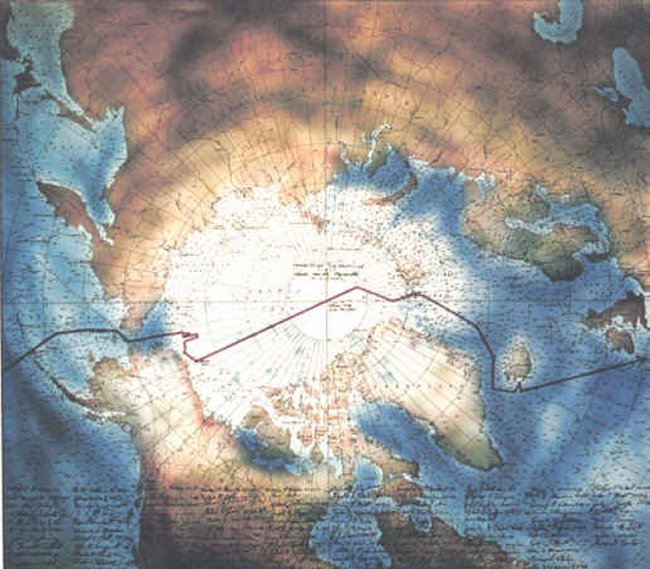
By 23 July, she returned northward, submerging in the Barrow Sea Valley (1 August) and two days later at 23:15 PM she became the first watercraft to reach the geographic North Pole, accompanied by a famous log sheet. This was made possible by the North American Aviation N6A-1 Inertial Navigation System. Previously indeed, navigating with classic systems relying on sky configuraiton by night for example was no longer possible. The trip was done at some point, at near-maximul depht of 700 ft, under a huge depht of pack ice, in pitch black conditions. Above 85°N both indeed magnetic compasses and normal gyrocompasses become inaccurate and this became “longitude roulette”. There was no way a classic navigaton system would do, so engineers had the idea to adapted a system based on the Navaho cruise missile’s N6A system. It installed on Nautilus and also USS Skate after initial sea trials on USS Compass Island in 1957.
She departed from the North Pole for a run of 96 hours over 1,590 nmi (2,940 km; 1,830 mi) under the ice, to surface northeast of Greenland. She made history with the first submerged voyage around the North Pole. Scientists from the Naval Electronics Laboratory were all thrilled, notably the mediatic Dr. Waldo Lyon aboard USS Nautilus as chief scientist and ice pilot.
This was risky endeavour. In case of a serious hazard which would have forced the sub to surface, Commander Anderson considered using torpedoes to blow a hole in the ice…
The Bering Strait crossing of the first crossing was made under 60 ft (18 m) of water below sea level, there just was no room between ice and bottom. The second was through a channel close to Alaska.
Proceeding south from Greenland, she surfaced and Captain Anderson wet top the deck to be airlifted by helicopter directly to Washington D.C. for a White House ceremony on 8 August. Here President Eisenhower was presented the famous log page “0 longitude-latitude” and in turn, presented Anderson with the Legion of Merit and a crew’s Presidential Unit Citation, a first in peacetime. He announced in his speech that one day nuclear cargo submarines might use that route for trade, but to the Soviets the message was clear.
USS Nautilus, meanwile arrived at the Isle of Portland, England, to receive her Unit Citation from American Ambassador JH Whitney from London. She crossed the Atlantic back to New London on 29 October for a well deserved rest after a city’s parade.
Later service and overhauls 1959-1979
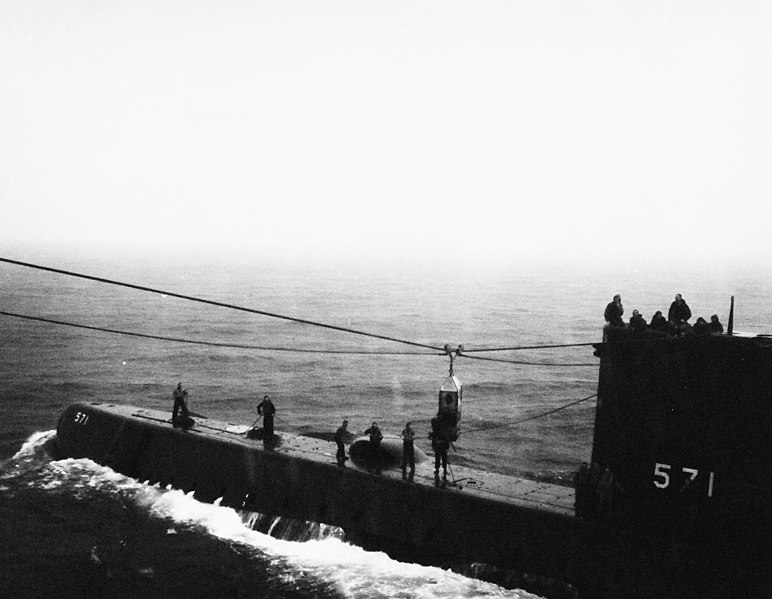
Personal transfer from a ship via Tyrolian line.
By early 1959, USS Nautilus started exercizes, until sent to the Portsmouth Naval Shipyard (Maine) for her first of two major overhauls from 28 May 1959 to 15 August 1960. There was a short (4 month and a half) core change, refreshing of many powerplant elements, cleaning and replacement of all lines, etc. as well as eletrical equipments upgrades and new radar. This was followed by sea trials and a refresher training. After her post-fixes she departed on 24 October for her first deployment with the 6th Fleet in the Mediterranean. There again, she made numerous port calls, enabling officials to visit her and showing the flag. On 16 December she was back to her homeport.
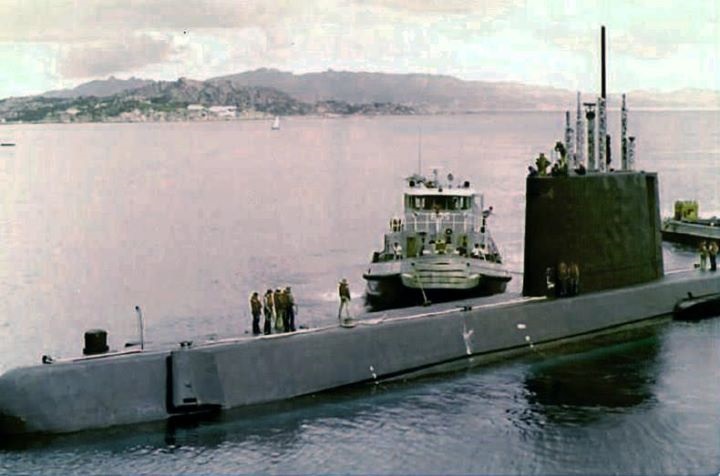
Nautilus in Sardinia, during her first Med TOD.
Next as part of Submarine Squadron 10, berthed in State Pier, New London she joined the squadron tender to upgrade maintenance procedures, and doing some preventive maintenance and a few repairs with USS Fulton (AS-11). She soon returned for exercises in the Atlantic, all geared towards improving ASW tactics, and NATO exercises. By October 1962 she took part in the quarantine of Cuba, a first for a nuclear sub. She pinged Russian diesels subs in these waters. Next she returned for a second, but short 2-month Mediterranean TOD from August 1963. She entered Portsmouth NyD for asecond and last overhaul from 17 January 1964 until 2 May 1966, with notably new sensors changes and probably new torpedo types embarked. It was also urgent to reduce her noise issues. Toward the end of her service both hull and sail vibrated so much that her sonar became “blind” to anything beyond 4 knots (7.4 km/h; 4.6 mph) of speed. She clearly also fell to sonar detection. A few measured were taken but nothing was practicable but a full reconstruction. Thus, her service afterwards was limited, but lessons were well taken for future SSNs.
USS Nautilus departed New London for the Atlantic Fleet thus logging her 300,000th nautical mile underway and made a serie of “special operations” for ComSubLant (classified). From August 1967 she was back to Portsmouth for extra refit. There was an incident, during an exercise on 10 November 1966 she went too close -and colided with- USS Essex at shallow depth. She was repaired in Portsmouth and resumed exercises on the southeastern seaboard. Back to HP New London in December 1968 she returned with SuBron 10 for another ten years of routine service.
Decommission and Museum

Tugged into place in New London, 1985
On 9 April 1979 she departed Groton, her builder, for a final voyage under command of Richard A. Riddell whch brought her to Mare Island Naval Shipyard (Vallejo) by 26 May 1979. She was decommissioned there, stricken on 3 March 1980.
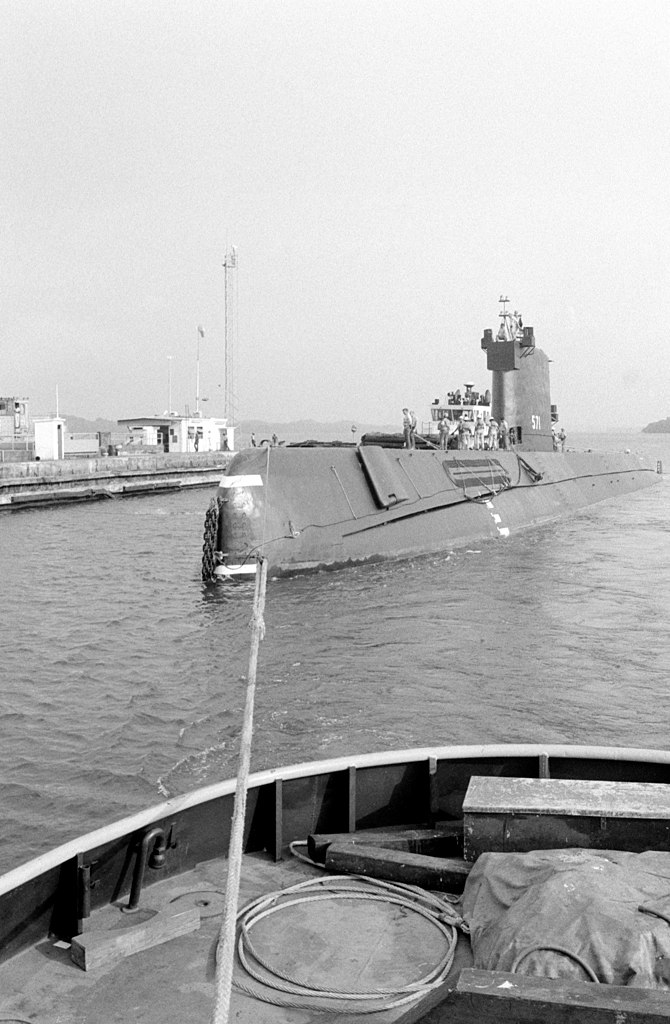
A port bow view of the nuclear-powered attack submarine ex-USS NAUTILUS (SSN 571) being towed into the Gatun Locks by canal commission tugs during its transit of the canal. The NAUTILUS is en route to its original home port at Naval Submarine Base, New London, Connecticut, where it will become a memorial at the Submarine Force Library and Museum.
She would be awared a Presidential Unit Citation with “For outstanding achievement in completing the first voyage in history across the top of the world, by cruising under the Arctic ice cap from the Bering Strait to the Greenland Sea” and National Defense Service Medal for Operation Sunshine clasp.
She could have been scrapped in 1980 and was placed in the disposal list, but was designated a National Historic Landmark by US Secretary of the Interior, on 20 May 1982.
She was to be based in Connecticut by 1983 butr received an extensive conversion at Mare Island Naval Shipyard to refit her as a museum ship (notably decontaminated), and towed back to Groton, under Captain John Almon on 6 July 1985. By 11 April 1986 she opened to the public (Submarine Force Library and Museum) and now under the Naval History and Heritage Command. She underwent anotther preservation refit in 2002 at Electric Boat. USS Nautilus nowadays is visited annually by 250,000 visitors while berthed in New London.

Underway for maintenance as museum ship in 2002
She celebrated her 50th anniversary on 30 September 2004 attended by Vice Admiral Eugene P. Wilkinson, first Commanding Officer. She was also presented with the American Nuclear Society National Nuclear Landmark badge. To that point, tours aft of the control room are not permitted for safety and security.
By March of 2022 she underwent a new restoration process for 6-8 months, notably maintaining her hull, new top decks, upgraded interior lighting/electrical lighting, completed at US$36 million. She reopened in late 2022.
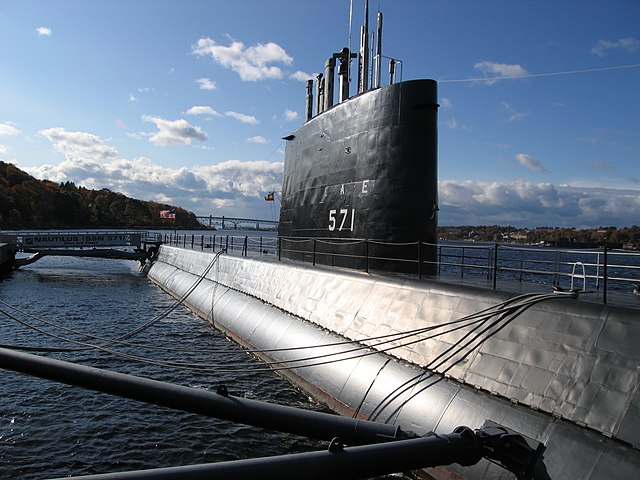
As of today.
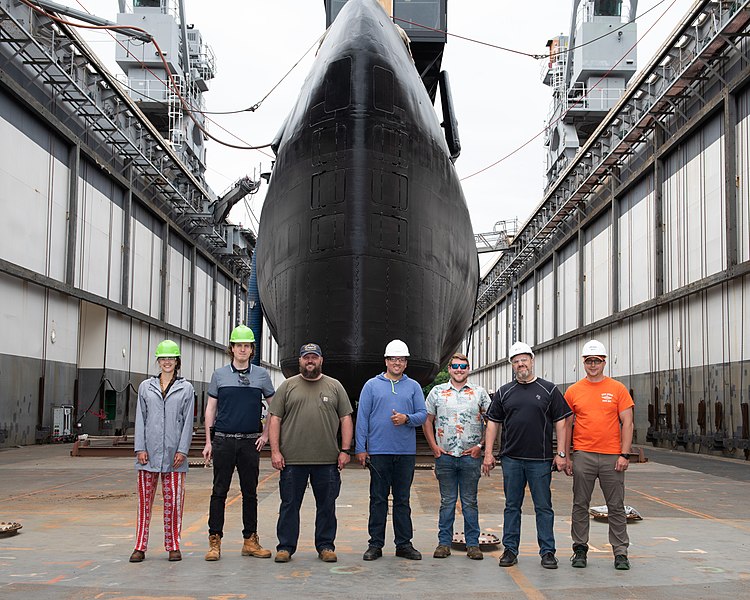
The team in charge of the maintenance poses for a drydock photo, June 2022
Significance
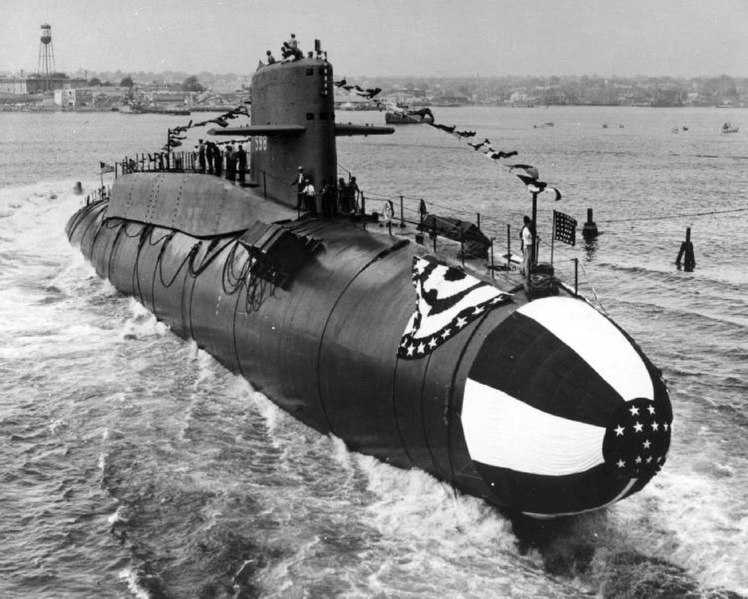
GROTON, Conn. (June 9, 1959) The ballistic-missile submarine USS George Washington (SSBN 589) slides down the ways during her launching ceremony at Electric Boat Division of General Dynamics Corporation, Groton, Conn. George Washington was originally scheduled to become USS Scorpion (SSN 589) but during her construction she was lengthened by the insertion of a 130-foot missile section and was finished as a fleet ballistic-missile submarine. George Washington was commissioned as the Navy’s first nuclear-powered fleet ballistic-missile submarine on Dec. 31, 1959. (U.S. Navy photo/Released). This was another landmark
USS Nautilus announced a new submerine era, negating all WW2-era countermeasures: Radar and anti-submarine aircraft, crucial in defeating submarines, proved now ineffective against a vessel that coukd so fat underwater and change depth quickly or staying submerged near-indefinitely. The while ASW doctrine was made obsolete and new ones were to be found. USS Nautilus thus was as history-shaking as was HMS Dreadnought for its time.
Both USS Nautilus and Seawolf were built under the FY52 programme, as SSN prototypes. But only the first really retained attention today. The story of USS Nautilus is in line with great technological advances and the men behind programs that enabled it. Nuclear propulsion is the last major advance in ship propulsion (that is also submarine propulsion). Although AIOP is now a popular way to propel “conventional” subs today underwater, nother comes close to nuclear for raw power and range. For nations that can afford these today (USA, Russia, China, UK, France) they are the go-to submarine choice for deterrence (SSBNs) and protect it underwater with equally powered SSNs. Why nuclear propulsion is not more mainstream for subs is a matter of choice, but also cost, practicability, risk assessment and treaties restrictions.
There is a ban on nuclear ships (that includes subs) in many harbours worldwide which limit operational possibilities in case of damage repir, although alleviated by the range which allows such submarine to circle the world and get back to the home port, and only tolerance from the crew’s nerves and food supplies. In all occurence, USS Nautilus was the first submarine to use a safe and reliable means of air-independent propulsion (AIP) – a technology that had consisted, to date, of experimental closed-cycle combustion engines fed by bottled or chemical sources of oxygen that were inherently unsafe.
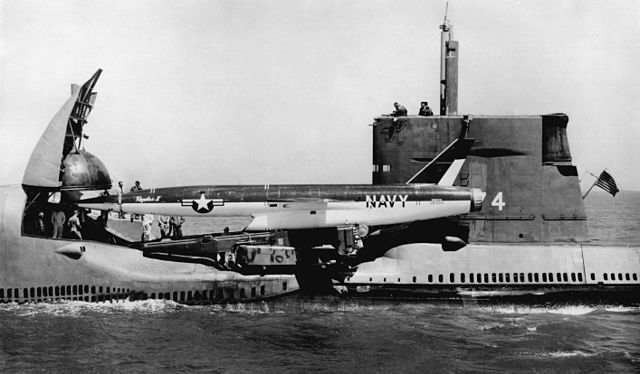
At the same time USS Nautilus was completed for tests, the USN tested their first atomic cruise missile launcher submarine, USS Grayback.
Since the record underwater cruise of USS Triton, the nuclear submarine performs almost routine exploits, being in “secret service” by nature, always “somewhere” to patrol, gather intel or place deterrence points on the world’s map ready to launch doomsday anywhere, whenever required. This is also why deterrence mostly relies today on SSBNs (the navy got its revenge on the air force): Bombers can be shot down, and fixed ground missile sites, one day or the other with the advances in satellite phot accuracy, are always discovered and catalogued. A SSBN is by nature an invisible launch point. Its shadowy presence ensure rogue nation’s military ambitions checked and the greater ones at forced peace through MAD. But despite of it, it never prevented conventional wars to happen, as a common undertanding is that nuclear use, even tactical and very limited would trigger a very dangerous, soapy slope towards full on nuclear war. It’s the red line today everyones recoignises.
Anyway, creating a first nuclear missile launcher submarine, even experimental, happened at the same time the first experimental nuclear-powered sub was made. It was possible only because of USS Nautilus, the one and only precursor. Stage one of this quest. Stage two was to fit ballistic subs in a nuclear powered one, as least as long as the US and NATO were concerned although some nations proceeded differently. France had its SSBNs before SSNs and Russia had conventional SSBs before SSBNs.
However as AIOP tech grows in sophistication and performances, the SSN solution seems less and less relevant, at least for Attack Subs. Sweden went for Stirling engine AIP, Japan, France and Germany towards fuel cells. It allows a month and more underwater so far, and this is just the beginning.

Poscard in Groton, Conn. “first atomic submarine”.
The Nautilus could in theory also stay submerged indefinitely and to prove it, crossed 1,800 miles under the Arctic ice by the summer of 1958, from the Bering Strait to the eastern coast of Greenland; This was a history changing even for the Cold War. The Soviets had the time had a 450-to-110 advantage in submarines over the US, and just launched Sputnik I, to under the blessing of “Ike”, the United States could now reset the clock and retained the world’s medias attention when unveiling a boat which could patrol from Murmansk to Vladivostok, the whole coastline of the Soviet Union, making quite a statement as the Regulus nuclear-armed guided cruise missiles when just announced ready. The US were back in technological superiority and although this was questioned a few times (Kirov, the November class (through speed), the Echo-Charlie-Oscar missile subs, Typhoons, the Alfa class, the Ekranoplanes…) the Soviet Union wasted money in prestige projects, ultimately leading to the collapse and end to the cold war.
Read More
Books
Christley, Jim; Bryan, Tony. US Nuclear Submarines: The Fast Attack. Osprey.
Polmar, Norman; Moore, Kenneth J. Cold War submarines: the design and construction of US and Soviet submarines. Brassey’s.
“National Register Information System”. National Register of Historic Places. National Park Service.
“Nautilus (Nuclear Submarine)”. National Historic Landmark summary listing. National Park Service.
Winters, Ann (28 March 2017). “Underway on Nuclear Power” The Man Behind the Words: Eugene P. “Dennis” Wilkinson, Vice Admiral USN. The American Nuclear Society.
Hewlett & Duncan, Nuclear Navy, pp. 162
“Biography of Admiral Hyman G. Rickover”. Naval History & Heritage Command.
“Lab’s early submarine reactor program paved the way for modern nuclear power plants”. Argonne’s Nuclear Science and Technology Legacy (Press release). 21 January 1996.
“Argonne National Laboratory News Release, 21 January 1996, retrieved 31 December 2014”.
“Reactors designed by Argonne National Laboratory, retrieved 31 December 2014”.
“Nautilus IV (SSN-571)”. Dictionary of American Naval Fighting Ships. Naval History & Heritage Command
Anderson, William R. “Fact Sheet – USS Nautilus and Voyage to North Pole, August 1958” (PDF).
“History of USS Nautilus (SSN 571)”. Submarine Force Library and Museum.
Steel Boats, Iron Men: History of the US Submarine Force. Turner. 1994. p. 71.
Leary, William M. (1999). Under Ice: Waldo Lyon and the Development of the Arctic Submarine. College Station, TX: Texas A&M University Press.
Konstam, Angus (May 2010) [2008]. Naval Miscellany. Oxprey.
Anderson, William R; Blair, Clay (May 1989) [1959]. Nautilus 90 North. McGraw-Hill.
“Navy retires Nautilus sub after 25 years”. Eugene Register-Guard. (Oregon). Associated Press. 4 March 1980.
Norman Polmar and Kenneth J. Moore (14 May 2014). “Chapter 4”. Cold War Submarines. The Design and Construction of U.S. and Soviet Submarines. Potomac Books, 2004.
Sheire, James W. (12 February 1982). “National Register of Historic Places Inventory-Nomination / USS Nautilus (SSN-571)” (pdf).
Friedman, Norman (1994). U.S. Submarines Since 1945: An Illustrated Design History. NIP
Hewlett, Richard; Duncan, Francis (1974). Nuclear Navy 1946-1962. Chicago, Illinois: University of Chicago Press.
Links

http://www.hisutton.com/USS-Naultius-First-Nuclear-Submarine.html
https://www.subguru.com/nautilus571.htm
https://ussnautilus.org/history-of-uss-nautilus/
http://www.infomercantile.com/blog/labels/uss%20nautilus.html
https://www.history.navy.mil/browse-by-topic/ships/submarines/uss-nautilus.html
http://www.navweaps.com/Weapons/WTUS_PostWWII.php
http://www.navypedia.org/ships/usa/us_ss_nautilus.htm
https://www.ans.org/news/article-1635/they-harnessed-the-atom-the-first-navy-prototype-nuclear-plant/
americanmilitarynews.com/ uss-nautilus-the-worlds-first-operational-nuclear-submarine-is-commissioned-by-the-u-s-navy/
https://commons.wikimedia.org/wiki/Category:USS_Nautilus_(SSN-571)
Videos
Laying down ceremony of USS Nautilus (hosted archive)
https://www.youtube.com/watch?v=-K39k10TUj8
Model Kits
modelshipmaster.com USS-Nautilus.htm
building the RC version, 1/72 of Nautilus
conceptbunny.com/uss-nautilus-ssn-571/


 Latest Facebook Entry -
Latest Facebook Entry -  X(Tweeter) Naval Encyclopedia's deck archive
X(Tweeter) Naval Encyclopedia's deck archive Instagram (@navalencyc)
Instagram (@navalencyc)





 French Navy
French Navy Royal Navy
Royal Navy Russian Navy
Russian Navy Armada Espanola
Armada Espanola Austrian Navy
Austrian Navy K.u.K. Kriegsmarine
K.u.K. Kriegsmarine Dansk Marine
Dansk Marine Nautiko Hellenon
Nautiko Hellenon Koninklije Marine 1870
Koninklije Marine 1870 Marinha do Brasil
Marinha do Brasil Osmanlı Donanması
Osmanlı Donanması Marina Do Peru
Marina Do Peru Marinha do Portugal
Marinha do Portugal Regia Marina 1870
Regia Marina 1870 Nihhon Kaigun 1870
Nihhon Kaigun 1870 Preußische Marine 1870
Preußische Marine 1870 Russkiy Flot 1870
Russkiy Flot 1870 Svenska marinen
Svenska marinen Søværnet
Søværnet Union Navy
Union Navy Confederate Navy
Confederate Navy Armada de Argentina
Armada de Argentina Imperial Chinese Navy
Imperial Chinese Navy Marinha do Portugal
Marinha do Portugal Mexico
Mexico Kaiserliche Marine
Kaiserliche Marine 1898 US Navy
1898 US Navy Sovietskiy Flot
Sovietskiy Flot Royal Canadian Navy
Royal Canadian Navy Royal Australian Navy
Royal Australian Navy RNZN Fleet
RNZN Fleet Chinese Navy 1937
Chinese Navy 1937 Kriegsmarine
Kriegsmarine Chilean Navy
Chilean Navy Danish Navy
Danish Navy Finnish Navy
Finnish Navy Hellenic Navy
Hellenic Navy Polish Navy
Polish Navy Romanian Navy
Romanian Navy Turkish Navy
Turkish Navy Royal Yugoslav Navy
Royal Yugoslav Navy Royal Thai Navy
Royal Thai Navy Minor Navies
Minor Navies Albania
Albania Austria
Austria Belgium
Belgium Columbia
Columbia Costa Rica
Costa Rica Cuba
Cuba Czechoslovakia
Czechoslovakia Dominican Republic
Dominican Republic Haiti
Haiti Hungary
Hungary Honduras
Honduras Estonia
Estonia Iceland
Iceland Eire
Eire Equador
Equador Iran
Iran Iraq
Iraq Latvia
Latvia Liberia
Liberia Lithuania
Lithuania Mandchukuo
Mandchukuo Morocco
Morocco Nicaragua
Nicaragua Persia
Persia San Salvador
San Salvador Sarawak
Sarawak Uruguay
Uruguay Venezuela
Venezuela Zanzibar
Zanzibar Warsaw Pact Navies
Warsaw Pact Navies Bulgaria
Bulgaria Hungary
Hungary

 Bundesmarine
Bundesmarine Dutch Navy
Dutch Navy Hellenic Navy
Hellenic Navy Marina Militare
Marina Militare Yugoslav Navy
Yugoslav Navy Chinese Navy
Chinese Navy Indian Navy
Indian Navy Indonesian Navy
Indonesian Navy JMSDF
JMSDF North Korean Navy
North Korean Navy Pakistani Navy
Pakistani Navy Philippines Navy
Philippines Navy ROKN
ROKN Rep. of Singapore Navy
Rep. of Singapore Navy Taiwanese Navy
Taiwanese Navy IDF Navy
IDF Navy Saudi Navy
Saudi Navy Royal New Zealand Navy
Royal New Zealand Navy Egyptian Navy
Egyptian Navy South African Navy
South African Navy






























 Ukrainian Navy
Ukrainian Navy dbodesign
dbodesign